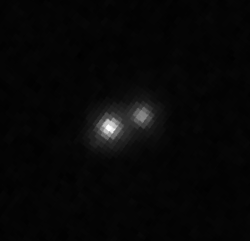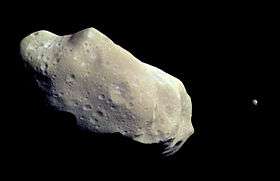469705 ǂKá̦gára
469705 ǂKá̦gára,[1] official designation (469705) 2005 EF298, is a trans-Neptunian object and binary system of the core Kuiper belt, located in the outermost region of the Solar System. It was discovered on 2005 March 11 by Marc William Buie at Kitt Peak Observatory. The primary body measures perhaps 140 kilometers (90 miles) in diameter. Its ≈120-kilometer (75-mile) companion ǃHãunu was discovered with the Hubble Space Telescope in 2009. The ǂKá̦gára–ǃHãunu system is currently undergoing mutual occultation and eclipsing events in which one body casts its shadow upon or obstructs the view of the other.
 Stacked Hubble Space Telescope images of ǂKá̦gára and ǃHãunu | |
| Discovery | |
|---|---|
| Discovered by | Marc William Buie |
| Discovery site | Kitt Peak Observatory |
| Discovery date | 2005 |
| Designations | |
| (469705) 2005 EF298 | |
| Pronunciation | |
Named after | ǂKá̦gára (San mythology)[1] |
| Cold classical KBO[1] | |
| Orbital characteristics[2][3] | |
| Epoch (JD 2458600.5) | |
| Uncertainty parameter 3 | |
| Observation arc | 10.10 yr (3688 d) |
| Aphelion | 44.058 AU |
| Perihelion | 40.013 AU |
| 44.081 AU | |
| Eccentricity | 0.085 |
| 292.45 yr (106744.25 d) | |
| 118.059° | |
| 0.00337 0° 0m 0s / day | |
| Inclination | 1.60° |
| 118.059° | |
| 77.966° | |
| Known satellites | 1 |
| Physical characteristics | |
Mean diameter | 138+21 −25 km, assuming same albedo as ǃHãunu |
| Mass | (1.29±0.07)×1018 kg, assuming same mass and albedo as ǃHãunu |
Mean density | 1.1+0.9 −0.4 g/cm3, assuming equal compositions of the bodies |
| HV = 6.2±0.5 | |
Names
The proposed names ǂKá̦gára and ǃHãunu are from the mythology of the ǀXam people of South Africa. ǂKá̦gára (also rendered ǂKaʻgara) and his brother-in-law ǃHãunu fought an epic battle in the east using thunder and lightning, producing mountainous clouds and rain. The conflict was over ǂKá̦gára's returning his younger sister, ǃHãunu's wife, to their parents.[1][4] The proposed names must be approved by the International Astronomical Union's Working Group for Small Body Nomenclature before they become official.
In the ǀXam language, the names are thought to have been pronounced [ǂ͡káˤɡáɾa] (![]()
![]()
Orbit and occultations
ǂKá̦gára is a cold classical Kuiper belt object. It orbits the Sun at a distance of 44 AU once every 290 years. Its orbit has an eccentricity of 0.09 and an inclination of 3° with respect to the ecliptic.[2]
If the two bodies are spheres with equal density, then mutual occultation events between ǂKá̦gára and its satellite ǃHãunu should have begun in 2015 and should continue until 2035. When ǂKá̦gára passes in front of ǃHãunu, events may last as long as 8 hours, but when ǃHãunu passes in front of ǂKá̦gára, they are expected to last as long as 2 days. These latter events are only expected to occur from 2022 to 2027.[1]
Formation
Prograde orbits dominate tight binary systems such as 469705 ǂKá̦gára, those with satellite semimajor axes less than about 5% of their Hill radii. Grundy et al. suggest that this could be "the signature of planetesimal formation through gravitational collapse of local density enhancements such as caused by the streaming instability",[1] which has been suggested as the formative mechanism of the only visited planetesimal, 486958 Arrokoth.
Satellite, size and mass
| ||||||||||||||||||||||||||||||
469705 ǂKá̦gára has one known satellite, ǃHãunu. The magnitude difference between ǂKá̦gára and ǃHãunu is 0.59 mag. This corresponds to a difference in diameter of 13%, if the two bodies have the same albedo.[1]
The system mass is (2.18±0.12)×1018 kg, and, given the albedo, the bodies are equivalent to a single sphere of diameter 174+27
−32 km. This corresponds to a density of 1.1+0.9
−0.4 g/cm3. This does not particularly constrain the composition of the bodies, as the error bars cover the densities of both small, porous bodies and larger, collapsed bodies. (See 229762 Gǃkúnǁʼhòmdímà for discussion.) Assuming the two bodies have the same albedo and density, their masses are (1.29±0.07)×1018 kg and (0.89±0.05)×1018 kg, and their diameters are 138+21
−25 km and 122+16
−19 km.[1]
Notes
- Bleek & Lloyd wrote ⟨ǂk⟩ when the posterior release of the click was audible. Based on the sounds attested in the closely related language Nǁng, this [ǂ͡k] may therefore represent a palatal pulmonic-contour click, though this is not certain.
- Based on the co-occurrence of the letter ⟨H⟩ for aspiration of the click and the tilde for nasalization on the following vowel, together with the patterns of sounds in Nǁng, it is suspected that the click in ǃHãunu has delayed aspiration (i.e., is a long, aspirated, nasalized click), rather than a simple IPA: [ǃʰə̃unu], though again this is not certain.
References
- Grundy, W.M.; Noll, K.S.; Roe, H.G.; Buie, M.W.; Porter, S.B.; Parker, A.H.; Nesvorný, D.; Levison, H.F.; Benecchi, S.D.; Stephens, D.C.; Trujillo, C.A. (April 2019). "Mutual orbit orientations of transneptunian binaries". Icarus. doi:10.1016/j.icarus.2019.03.035. Retrieved 6 April 2019. (heliocentric parameters averaged over 10Myr)
- "JPL Small-Body Database Browser: 469705 (2005 EF298)" (2015-04-06 last obs.). Jet Propulsion Laboratory. Retrieved 7 April 2019.
- "469705 (2005 EF298)". Minor Planet Center. Retrieved 7 April 2019.
- ≠kagara's fight with !haunu in the east. Lucy Lloyd |xam notebooks, vol. VIII-30, July 1879.
- Will Grundy: 469705 (how to say)
- "ǂKá̦gára and ǃHãunu (469705 2005 EF298)". Mutual Orbits of Binary Transneptunian Objects. Retrieved 7 April 2019. (heliocentric parameters averaged over 10Myr)
External links
- 469705 ǂKá̦gára at AstDyS-2, Asteroids—Dynamic Site

